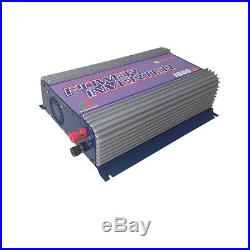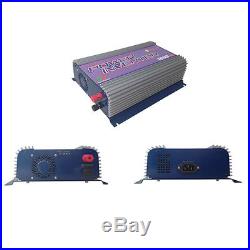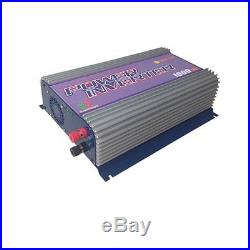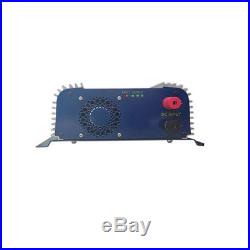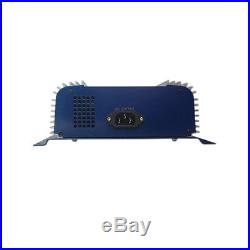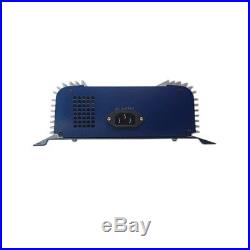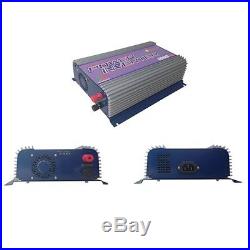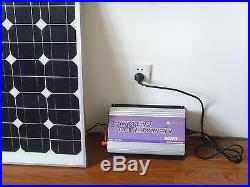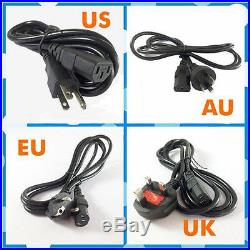August
18
10.5 V-28 V DC 400 Watts Mppt Grid Tie Inverter 110 V-120 V/190 V-240 V Ac 60 Hz
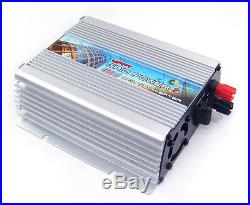

400W Grid Power 2. For Solar & Wind Hybrid Systems. MPPT to Enhance Power Output by 30%! What is a Micro Grid-Tie Inverter? First, we should know what a Grid-Tie Inverter is. A Grid-Tie Inverter is a device that that can transform DC electricity (ie: Solar Panels, Wind Turbine, Battery Storage) into AC power that can be directly injected into your utility’s electricity network (the power grid). As of today, most inverters available in the market are in the high output (1000W 5000W) category. Their prices ranges in the thousand’s range and it is just too much of an up front cost for anyone interested in green energy generation. In addition, because of the high output, a certified electrician will need to be hired to install the equipments and connect the cables. Ever since we invented the first generation of the Micro Grid Tie Inverters, connecting to the grid has never been this easy and affordable. This is the perfect start up solution for anyone interested in green energy generation as it is affordable and maintenance free. In addition, our inverters are stackable ; meaning multiple unit of these devices can be connected in parallel to generate a higher output. It is up to us. Up to this generation. To lead mankind into a greener future. Non- Reusable Power being consumed today. Reusable Power being generated for a better tomorrow and a brighter future. What’s New in the MPPT 2nd Generation? So you ask, What’s new in this MPPT revision of the 2nd Generation Inverter? Well, the Maximum Power Point Tracking (MPPT) algorthim has been improved to match our 3rd generation inverters. Aside from that, there are number of upgrades in performance, safety and display that are not available in the first generation or other inverters in the market. We will use our Enviro-Techs SSI-200W first generation inverter as the base model for comparison. Here are the high lights. Maximum Power Point Tracking (MPPT). What is Maximum Power Point Tracking (MPPT)? MPPT is a techinque we implemented to get the maximum possible power from a solar panel. When trying to characterize the output of a solar panel mathematically, it can be represented by an IV-Curve (shown below). The equation for Power is P = IV. Where I is the Current , V is the Voltage , and P is the possible output Power. Each point on the curve is a possible combination for output power and our goal is to find the best combination to obtain maximum power. In simple terms, we are trying to get the biggest rectangle to fit under this so called IV-Curve, the bigger rectangle we can fit, the more power we get. Below are graphs to help you understand the idea better. This is a comparison between inverters with and without MPPT on an 85W solar panel. Please note that different solar panels will have slightly different IV-Curves. No Tracking Vs Tracking. Figure 1 No MPPT, with voltage fixed 17.5V P = 17.5V x 4.6A = 80.5W. Figure 2 With MPPT, amount of current and voltage to draw are calculated P = 17V x 4.95A = 84.15W. As we can see, Figure 2 is able to 84.15W with MPPT while in Figure 1, we can only get 80.5W. This is 4.5% increase in power output. Why do we care? Because solar panels are still quite expensive these days, and the increased power output will directly affect our return on investment (ROI). In addition, depending on weather, time of the day and amount of solar irradiation the panel receives, the IV curve will move along the Y-axis to reflect the possible increase / decrease in potential power output, and cause the maximum power point to shift along as well. Coming up are illustrations to visualize this idea. IV-Curves Under different weather conditions. Sunny, Clear Sky days in Summer 600 1000 W/m2. Scattered Clouds or Partly Cloudy days in Summer 300 600 W/m2. Cloudy or fog days, dawn or dusk in Summer 100 300 W/m2. Figure 3 – 5 illustrate the power gain in different weather condition with MPPT compare to a non-tracking inverter that locks voltage at 17.5V. While 17.5V is randomly chosen, it does show what would happen in real life when there is not MPPT. Studies have shown, by making use of MPPT, there will be an average of 30% increase in power production. Since the maximum power point is a variable, we have implemented a tracking algorithm that utilizes the micro processing power of our inverter to calculate the optimum voltage and current to maximize our energy harvest. 152 x 143 x 57 mm. 163 x 154 x 57 mm. 400W, 60% enhanced in Power Output – 38.5% better in Space Utilization. 51% better in Weight Reduction with. New Model: GP2A-400 Second Generation Normal Operation. AC Disconnected / Fault. Unique and intuitive display design – LED cycling in circular formation – Represent electric meter spinning backward and power is being output to the grid – Smooth motion. Old Model: SSI-200W First Generation LED Display (reference only). 3 Green LED moving from left to right linearly – LED movement are somewhat not continuous due to the fact that motion breaks off at the last light. New Model: GP2A-400 (30A External Fuse). External 30A Fuse for easy maintenance -Utilizing low resist DC input circuit to increase efficiency. Reverse Polarity protection – Buzzer will alarm when fuse need to be replaced – Reduce internal temperature. Old Model: SSI-200W (Internal Fuse). Hard to maintenance – Need to remove knobs and remove bottom plate – Heat generated by the fuse will stay inside the inverter. Automatic AC Voltage & Wider Voltage Range for DC input. New Model: GP2A-400 Automatic Voltage Switch. Automatically Switch between 110V 220V AC – Compatible with grids from ANY countries. No more manual switch – Avoid unit being damaged because of human mistakes – Cleaner User Interface – Wider DC Input Voltage Range 10.8V 28V – Allow MORE types of power source to be connected (ie: Air-X, 12V Battery , and etc). Old Model: SSI-200W Manual Voltage Switch. Easy to be overlooked and cause damage to inverter – Can be troublesome when there are multiple units – Narrow DC Input Voltage Range 14V 28V -14V is a range that is too high for starting wind turbines, and half charged 12V batteries. Feature: – Grid-Tied – sell green power directly back to the grid at a premium rate (depends on your location) – NEW Maximum Power Point Tracking (MPPT) algorthim to optimize power output – Plug and Play Design, simply plug into an outlet (GFI), no hard-wiring – 60% enhanced in power output compare to first generation inverters – 38% better in. And 51% better in. With higher quality parts – Unique and intuitive LED display design to reflect power output rate – External 30A Fuse for easy maintenance – Automatic 110V – 220V AC voltage switch, NO MORE manual hassle – Wider DC Input Voltage Range, from 10.8V 28V compare to 1st generation’s 14V 28V – Allow MORE types of power source to be connected ie: Air-X, 12V battery, and etc. Aluminum enclosure will act as heat sink to help dissipate heat – Stackable (connect in parallel for higher output) – Island protection: Inverter will shut down during black outs. Simple and safe installation – Reverse polarity protection – Generates pure Sine Wave – Constant Power Output – Low distortion output on all ranges – Allow different Power factor from loads – Does not require rewiring of existing electronics – Compact and light weight design Installation. Figure 1: AC Power. Figure 2: DC Input. Install in a low humidity and well-ventilated area. Remove all flammable objects. Connect the Solar Panel, Battery or Wind Turbine’s DC supply cables to the DC input terminal of the inverter as shown in Figure 2. Wind Turbine installations will require respective charge controllers and dump loads. Connect the inverter to a wall socket with the supplied AC Power Cord as shown in Figure 1. Pay close attention to the polarity of your DC input. Connecting incorrectly might blow the fuse. In such case the inverter will make a buzz sound whenever power is connected and the fuse will need to be replaced. Electrical Specifications – Output. Maximum AC Output Power. 100 260V Auto Switching. Total Harmonic Distortion (THD). Yes, inverter shuts down during black out. Electrical Specifications – Input. DC Input Voltage (Solar & Wind). 10.8V – 28V. Unlimited as long as it doesn’t exceed main circuit amperage limit. 20’C – 65’C. 1.27kg 2.65lb. Dimension (L x W x H). 16.3 x 15.4 x 5.7 cm 6.3″ x 6.10″ x 2.25. Wall Mount at base. Convection cooled with fan. 1 Red and 6 Green LED. Improper installation, accident, misuse. Any unauthorized disassembly, repair, or modification. View our other grid tie inverters. NO OPERATING COST GENERATES ELECTRICITY FROM THE ABUNDANT RESOURCE – SOLAR & WIND. All pictures and descriptions are subjected to change without notice. We are not responsible for any inadvertent errors. Items that are used/ damaged/ deformed or altered in any ways will not be accepted. Spams and mass e-mailing will be deleted without slightest glance. E-mails with virus or anything subjected to hacking are automatically deleted. The item “10.5 V-28 V DC 400 WATTS MPPT GRID TIE INVERTER 110 V-120 V/190 V-240 V AC 60 HZ” is in sale since Monday, January 09, 2012. This item is in the category “Home & Garden\Home Improvement\Electrical & Solar\Alternative & Solar Energy\Chargers & Inverters”. The seller is “hi_iq” and is located in Vancouver, British Columbia. This item can be shipped worldwide.
- Brand: GreenergyStar
- MPN: Does Not Apply
- Product Type: Inverter

